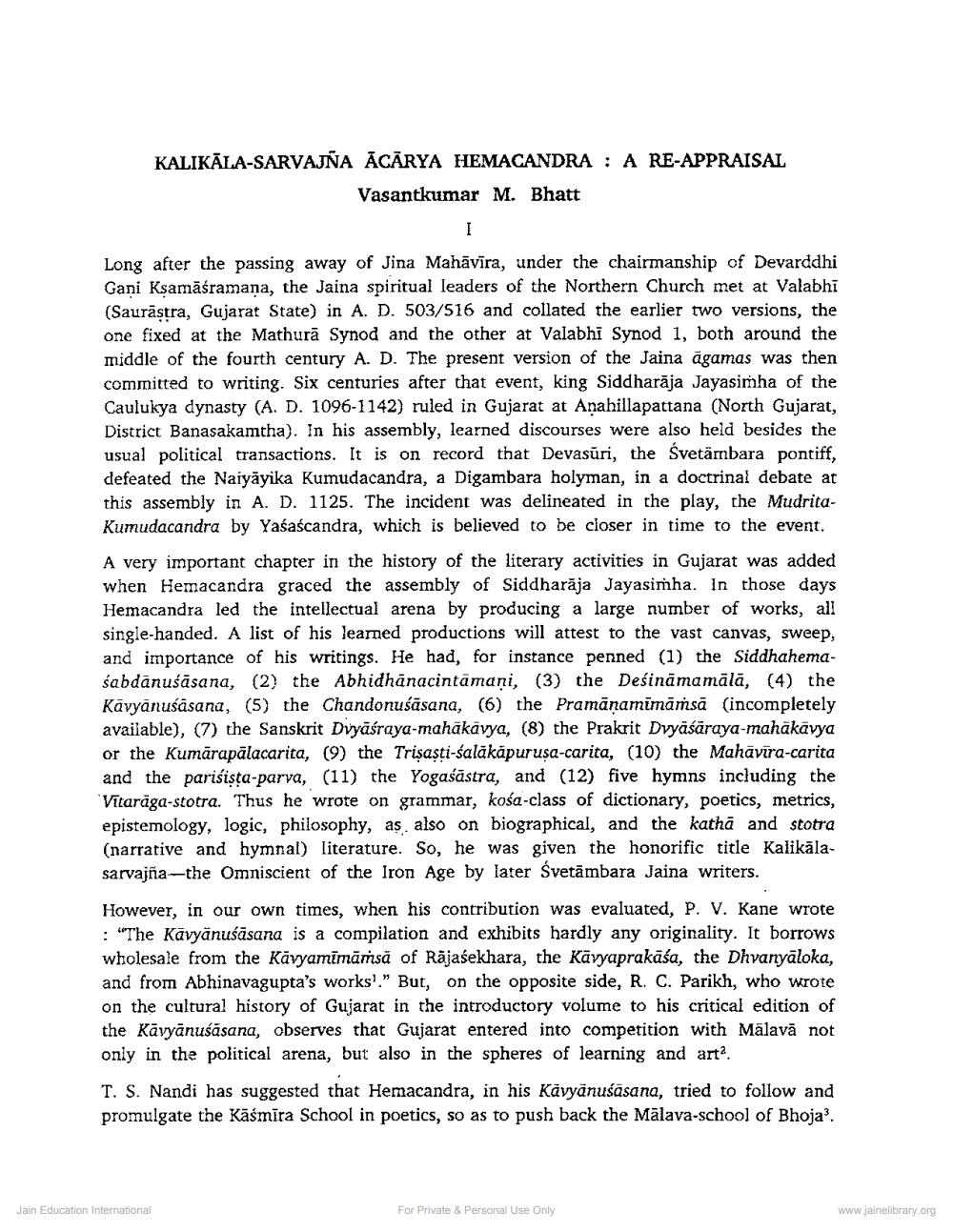Book Title: Kalikal Sarvagna Acharya Hemchandra A Re Appraisal Author(s): Vasant M Bhatt Publisher: Z_Nirgrantha_1_022701.pdf and Nirgrantha_2_022702.pdf and Nirgrantha_3_022703.pdf View full book textPage 1
________________ KALIKĀLA-SARVAJÑA ACARYA HEMACANDRA A RE-APPRAISAL Vasantkumar M. Bhatt I Long after the passing away of Jina Mahavira, under the chairmanship of Devarddhi Gani Kṣamāśramaṇa, the Jaina spiritual leaders of the Northern Church met at Valabhi (Saurastra, Gujarat State) in A. D. 503/516 and collated the earlier two versions, the one fixed at the Mathura Synod and the other at Valabhi Synod 1, both around the middle of the fourth century A. D. The present version of the Jaina agamas was then committed to writing. Six centuries after that event, king Siddharāja Jayasimha of the Caulukya dynasty (A. D. 1096-1142) ruled in Gujarat at Anahillapattana (North Gujarat, District Banasakamtha). In his assembly, learned discourses were also held besides the usual political transactions. It is on record that Devasuri, the Svetämbara pontiff, defeated the Naiyayika Kumudacandra, a Digambara holyman, in a doctrinal debate at this assembly in A. D. 1125. The incident was delineated in the play, the MudritaKumudacandra by Yaśaścandra, which is believed to be closer in time to the event. A very important chapter in the history of the literary activities in Gujarat was added. when Hemacandra graced the assembly of Siddharaja Jayasimha. In those days Hemacandra led the intellectual arena by producing a large number of works, all single-handed. A list of his learned productions will attest to the vast canvas, sweep, and importance of his writings. He had, for instance penned (1) the Siddhahemasabdanusāsana, (2) the Abhidhanacintamani, (3) the Dešināmamālā, (4) the Kävyänusäsana, (5) the Chandonusāsana, (6) the Pramāṇamimämsä (incompletely available), (7) the Sanskrit Dvyäśraya-mahakavya, (8) the Prakrit Dvyäsäraya-mahäkävya or the Kumarapalacarita, (9) the Triṣasti-salakäpurusa-carita, (10) the Mahavira-carita and the parisiṣṭa-parva, (11) the Yogaśästra, and (12) five hymns including the Vitaraga-stotra. Thus he wrote on grammar, kosa-class of dictionary, poetics, metrics, epistemology, logic, philosophy, as also on biographical, and the kathd and stotra (narrative and hymnal) literature. So, he was given the honorific title Kalikālasarvajña-the Omniscient of the Iron Age by later Svetambara Jaina writers. However, in our own times, when his contribution was evaluated, P. V. Kane wrote : "The Kävyänusäsana is a compilation and exhibits hardly any originality. It borrows. wholesale from the Kavyamimämsä of Rajasekhara, the Kavyaprakāśa, the Dhvanyaloka, and from Abhinavagupta's works'." But, on the opposite side, R. C. Parikh, who wrote on the cultural history of Gujarat in the introductory volume to his critical edition of the Kāvyānusāsana, observes that Gujarat entered into competition with Mālavā not only in the political arena, but also in the spheres of learning and art2. T. S. Nandi has suggested that Hemacandra, in his Kävyänuśäsana, tried to follow and promulgate the Kašmira School in poetics, so as to push back the Mälava-school of Bhoja". Jain Education International For Private & Personal Use Only www.jainelibrary.orgPage Navigation
1 2 3 4 5 6 7 8
